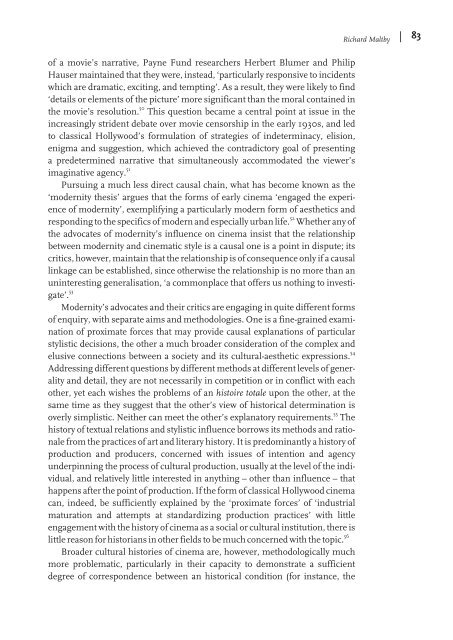Artikel: On the prospect of writing cinema history from below
Artikel: On the prospect of writing cinema history from below
Artikel: On the prospect of writing cinema history from below
You also want an ePaper? Increase the reach of your titles
YUMPU automatically turns print PDFs into web optimized ePapers that Google loves.
<strong>of</strong> a movie’s narrative, Payne Fund researchers Herbert Blumer and PhilipHauser maintained that <strong>the</strong>y were, instead, ‘particularly responsive to incidentswhich are dramatic, exciting, and tempting’. As a result, <strong>the</strong>y were likely to find‘details or elements <strong>of</strong> <strong>the</strong> picture’ more significant than <strong>the</strong> moral contained in<strong>the</strong> movie’s resolution. 50 This question became a central point at issue in <strong>the</strong>increasingly strident debate over movie censorship in <strong>the</strong> early 1930s, and ledto classical Hollywood’s formulation <strong>of</strong> strategies <strong>of</strong> indeterminacy, elision,enigma and suggestion, which achieved <strong>the</strong> contradictory goal <strong>of</strong> presentinga predetermined narrative that simultaneously accommodated <strong>the</strong> viewer’simaginative agency. 51Pursuing a much less direct causal chain, what has become known as <strong>the</strong>‘modernity <strong>the</strong>sis’ argues that <strong>the</strong> forms <strong>of</strong> early <strong>cinema</strong> ‘engaged <strong>the</strong> experience<strong>of</strong> modernity’, exemplifying a particularly modern form <strong>of</strong> aes<strong>the</strong>tics andresponding to <strong>the</strong> specifics <strong>of</strong> modern and especially urban life. 52 Whe<strong>the</strong>r any <strong>of</strong><strong>the</strong> advocates <strong>of</strong> modernity’s influence on <strong>cinema</strong> insist that <strong>the</strong> relationshipbetween modernity and <strong>cinema</strong>tic style is a causal one is a point in dispute; itscritics, however, maintain that <strong>the</strong> relationship is <strong>of</strong> consequence only if a causallinkage can be established, since o<strong>the</strong>rwise <strong>the</strong> relationship is no more than anuninteresting generalisation, ‘a commonplace that <strong>of</strong>fers us nothing to investigate’.53Modernity’s advocates and <strong>the</strong>ir critics are engaging in quite different forms<strong>of</strong> enquiry, with separate aims and methodologies. <strong>On</strong>e is a fine-grained examination<strong>of</strong> proximate forces that may provide causal explanations <strong>of</strong> particularstylistic decisions, <strong>the</strong> o<strong>the</strong>r a much broader consideration <strong>of</strong> <strong>the</strong> complex andelusive connections between a society and its cultural-aes<strong>the</strong>tic expressions. 54Addressing different questions by different methods at different levels <strong>of</strong> generalityand detail, <strong>the</strong>y are not necessarily in competition or in conflict with eacho<strong>the</strong>r, yet each wishes <strong>the</strong> problems <strong>of</strong> an histoire totale upon <strong>the</strong> o<strong>the</strong>r, at <strong>the</strong>same time as <strong>the</strong>y suggest that <strong>the</strong> o<strong>the</strong>r’s view <strong>of</strong> historical determination isoverly simplistic. Nei<strong>the</strong>r can meet <strong>the</strong> o<strong>the</strong>r’s explanatory requirements. 55 The<strong>history</strong> <strong>of</strong> textual relations and stylistic influence borrows its methods and rationale<strong>from</strong> <strong>the</strong> practices <strong>of</strong> art and literary <strong>history</strong>. It is predominantly a <strong>history</strong> <strong>of</strong>production and producers, concerned with issues <strong>of</strong> intention and agencyunderpinning <strong>the</strong> process <strong>of</strong> cultural production, usually at <strong>the</strong> level <strong>of</strong> <strong>the</strong> individual,and relatively little interested in anything – o<strong>the</strong>r than influence – thathappens after <strong>the</strong> point <strong>of</strong> production. If <strong>the</strong> form <strong>of</strong> classical Hollywood <strong>cinema</strong>can, indeed, be sufficiently explained by <strong>the</strong> ‘proximate forces’ <strong>of</strong> ‘industrialmaturation and attempts at standardizing production practices’ with littleengagement with <strong>the</strong> <strong>history</strong> <strong>of</strong> <strong>cinema</strong> as a social or cultural institution, <strong>the</strong>re islittle reason for historians in o<strong>the</strong>r fields to be much concerned with <strong>the</strong> topic. 56Broader cultural histories <strong>of</strong> <strong>cinema</strong> are, however, methodologically muchmore problematic, particularly in <strong>the</strong>ir capacity to demonstrate a sufficientdegree <strong>of</strong> correspondence between an historical condition (for instance, <strong>the</strong>Richard Maltby | 83
















